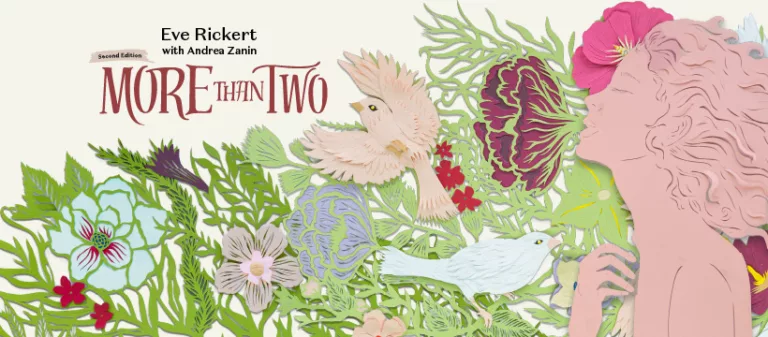Earlier this summer, a writer who goes by the pen name Elizabeth Stern published an article in Salon titled “Jealous of what? Solving polyamory’s jealousy problem.” My partner and I wrote the following as a response.
Anger is cruel and fury overwhelming, but who can stand before jealousy?
—Proverbs 27:4
Elizabeth Stern has hit the polyamory jackpot. She has two loving, secure partners who are highly compatible not just with her, but with each other. The two loves of her life like each other, share interests, and are actively supportive of each other’s relationship with her. And none of the trio has ever felt jealous.
We hope, for Stern’s sake, that she and her partners manage to remain forever in their blissful Eden. For many people, jealousy emerges just when it’s least expected, without foreshadowing. (Coincidentally, my partner first experienced jealousy four years into his first serious polyamorous relationship.) If this happens to Stern, we hope she will be able to grant her partners, her metamours (her partners’ other partners) and, perhaps especially, herself more patience, compassion and empathy than she has granted her readers.
Based on her description of her relationships, we can venture a few educated guesses about Stern and her partners: they are probably secure, with high self-esteem; they probably have good communication skills and a reasonable amount of experience in healthy relationships; Stern clearly has good partner-selection skills. We stress the importance of developing all these assets in our new book, More Than Two: A Practical Guide to Ethical Polyamory. They are also highly educated, financially stable and engaged in meaningful, fulfilling careers—that is, they have strong identities outside their romantic relationships.
Like someone who’s never suffered depression giving advice to someone who has, or someone who’s never encountered economic hardship critiquing the moral shortcomings of the poor, Stern looks to her own happiness and tries to decide what she’s doing right and others are doing wrong—because obviously, if everyone else would just do what she’s doing, they’d be as happy as she is. Like many people with unchecked privilege, she scoffs at those who must actually work at the things that come to her naturally. Advice aimed at those who must make an effort at learning communication, developing emotional self-awareness and building self-esteem only “soaks in a sea of middle-class self-actualization.”
Stern believes her lack of experience with jealousy makes her an expert on the subject. She conveniently chooses a solution to jealousy that most cleanly fits her personal worldview: the problem is individualism, and more specifically, the kind of bourgeois individualism that following the traditional Marxist line, always serves the interests of the ruling class.
To bolster her position, she invents a fantastical human past. It’s not clear what societies Stern was imagining when she talked about jealousy being a “non-issue” before the Industrial Revolution: does she long for lords and ladies, rosy-cheeked peasants and noble savages? Surely she cannot imagine that a return to feudalism and arranged marriages is the solution to jealousy we should be seeking? While it’s not clear exactly what kind of world she wishes we lived in, what is clear is that it’s not the world we do live in: Stern’s analysis is woefully uninformed about both human history and animal behavior.
Turning from Stern’s misty-eyed, nostalgic Utopia to the real world, a casual look at history and literature shows us that jealousy has always been part of the human condition. The Greek story in which Zeus’ wife, Hera, is consumed by jealous rage over the affair between Zeus and Seleme and engineers Seleme’s death; Unferth’s jealousy of Beowulf in the epic saga; Othello’s mad and destructive jealousy, constructed from whole cloth by Iago; Scheherazade’s husband Shahryār’s consuming jealousy at his betrayal, which sets the stage for One Thousand and One Nights; Rama’s abandonment of Sita in the Ramayana…all these show how deeply the roots of jealousy are embedded in the human condition.
Some people might argue that some of these cases of literary jealousy are not actually about sex or romance, but about status, property, politics or ideology. This observation is true, and it offers an important insight: jealousy is often not about relationships at all. It can be about social status, division of resources, or violation of taboos, among other things. In More Than Two we refer to jealousy as “a chameleon emotion.” Learning to recognize its many faces—and its many causes—is key to its management and ultimate banishment.
Jealousy starts young: it can be seen in infants as early as six months of age. Children get jealous of siblings, parents, other kids at school, mom’s or dad’s new partners—anyone they feel threatens the affection they rely on. This phenomenon is well–known. Would Stern have us believe it only occurs in the children (indeed, infants) of neoliberal capitalist parents?
As anyone who’s ever owned pets can tell you, jealousy is also not uniquely human. In The Myth of Monogamy: Fidelity and Infidelity in Animals and People, David Barash and Judith Lipton delve deep into the sexual behavior of non-human (and human) animals. It turns out, many animals display an array of behaviors that look an awful lot like what we call jealousy in humans. We see evidence of “jealous” behaviors in primates, birds and dogs (but presumably only capitalist dogs), among other animals.
We do not deny the social element of jealousy. In their book Sex at Dawn: How We Mate, Why We Stray, and What It Means for Modern Relationships, Christopher Ryan and Cacilda Jethá argue that pre-agrarian societies were openly promiscuous, and monogamy an invention to protect the accumulation of property. If one accepts their arguments, it may be that at least part of human jealousy is in fact a post-agrarian (though not post-industrial) invention, socially programmed and heavily linked to social status and economic security.
So what is jealousy, then? It’s a surprisingly tricky question, for unlike most emotions, jealousy is an amalgamation of many feelings and impulses. The word dates back to the 13th century, and the dictionary defines it as “intolerant of rivalry or unfaithfulness; disposed to suspect rivalry or unfaithfulness.” That says little about what causes it. We’re often told that jealousy is provoked by possibility: if a lover spends time with someone who could be a suitor, we feel jealous. Yet many people don’t feel jealous when a lover has sex with someone else, while others feel jealous if a lover even talks to someone of their preferred sex. Clearly, it’s not the external situation per se that creates jealousy. Jealousy is an individual internal response, but one almost certainly shaped by both nature and nurture.
Jealousy is often the fear of being replaced. It starts in us so young because it is, arguably, the first and purest expression of the ego. We cannot outsource the taming of our own egos; we cannot export the job of facing our own insecurity. Jealousy is not a one-size-fits-all problem, so a mass-produced, one-size-fits-all solution won’t succeed.
Stern’s conclusions about the roots of jealousy are naive, because she believes that since she and her partners have never experienced jealousy, it means they never will. They’re arrogant, because she believes that her single four-year polyfidelitous relationship with two men can serve as a model for all poly relationships. But her assertions are also dangerous.
One of the most common—and devastating—relationship mistakes a person can make is to assume, “I am feeling bad, so that means someone has done something bad to me.” Sometimes it’s true: abuse happens, cruelty and gaslighting happen, people can just be inconsiderate and unkind. Jealousy can be a signal: that something is wrong in a relationship, our needs aren’t being met, our partner really does have one foot out the door. Or it can be a social cue: our status is threatened.
But sometimes jealousy comes from inside, revealing insecurity or anxiety we need to confront and work through. Or it can be utterly irrational, arising blindly out of seemingly nowhere, perhaps from our social training—or perhaps an ancient biological urge encoded in our DNA. Perhaps a partner’s or metamour’s well-intentioned words or actions have tripped over deeply buried emotional trauma and unleash demons that make us feel like our world is going to end. The network is supportive, everyone is communicating—then a new situation is encountered and BAM! Jealousy. Feeling bad doesn’t always mean someone else is doing something wrong.
Stern’s view is dangerous, then, because often people feel jealous when no one is doing anything wrong. Treating jealousy as a purely social issue (and we’ve seen it done) can lead to an endless circle of judgment, recrimination and accusation. It’s the ultimate in outsourcing: the outsourcing of emotional responsibility. True jealousy management involves listening to the jealousy to find out what it’s trying to tell you, and communicating with your partners (and metamours) to discover whether there is truth behind your fears—and if not, to get the reassurance you need.
But Stern’s conclusion is dangerous for another, more insidious reason. The dense-network “polyfamily” model she describes is a good one for many people. Polyamory advocates, in fact, tend to choose closely networked co-habiting triads and quads (usually with children) as their poster families. When it works—and we’ve both seen many situations where it has—it’s amazing. It’s understandable to crave such a structure; many do, and some successfully create it. Those who are suited for such a life and have managed to build it themselves, as Stern has, are fortunate indeed.
But there’s a hidden trap when such structures become prescriptive. When everyone is expected to be “family” in order to stay in their relationships—or the converse, to stay in relationships in order to keep their “family”—such networks can easily, and with the best of intentions, slip into coercion. One of my partner’s ex-partners has written about how prescriptive family structures can become coercive, undermine consent, and strip away the most essential of relationship rights: the right to leave a relationship.
Stern advocates a structural approach, something actually quite common among people new to polyamory. “We just need to find the right social structure for our relationships!” “We’ll have a closed triad, where everyone loves everyone else, and then there will be no jealousy!” It’s easy to understand why; dealing with unpleasant emotions is hard, messy work, and we will reach for any excuse not to do it. Yet structural approaches to jealousy rarely succeed—and when they do, it’s usually because of luck, coincidence, or an already solid set of interpersonal skills.
In fact, we see, over and over again, that when we outsource responsibility for our relationships onto “society,” whatever “society” means in a given era, we end up with systems that strongly discourage any form of non-traditional relationship. For example, polyamory.
In fact, research has shown that societies that attach great social importance to specific, sanctioned social and sexual roles—for example, societies that highly value marriage and proscribe sex outside of sanctioned relationships—have greater incidence of jealousy, suggesting that reinforcing socially approved roles, far from being the “solution to the jealousy problem,” actually makes the problem worse.
Certainly it is true that in cases where everyone is able to share their feelings, where they feel seen and heard by their partners and their metamours, jealousy can be less likely to arise, and it’s usually easier to cope with when it does. And when multiple partners are able to enjoy each other’s company, time management and division of relationship “resources” can be much easier.
It is also true that poly relationships go much more smoothly when everyone actively supports each other’s relationships—and this idea is certainly nothing new to the poly advice literature. Columnist Mistress Matisse talked about “rooting for the home team,” and in More Than Two, we talk about the importance of “teamwork”:
Teamwork [among metamours]—or at least the possibility of it—is one of the things that makes polyamory stand out from other forms of non-monogamy. When they are going well, metamour relationships enrich the lives of everyone in a romantic network. Many people, in fact, see metamour connections as a prime benefit of polyamory. (p. 398)
It is not true, however, that close metamour relations, dense networks and social support make jealousy a “non-issue.” We’ve seen polyamorous groups of three or four people all closely connected with each other dissolve into jealousy, recrimination and, ultimately, dissolution. Ironically, Stern’s solution to the problem of jealousy is something we’ve seen cause jealousy: having strong social support for particular relationships can backfire dramatically when someone perceives a rival to be encroaching upon the socially approved role.
Stern claims that an “individualistic approach to relationships is also ‘convenient’ in that it allows partners to be dispensable.” But by seeing our partners as individuals, we recognize their uniqueness and irreplaceability. By seeing them in terms of their social role, instead, we make them interchangeable: it’s not the person who matters, it’s the role. And when partners feel interchangeable, jealousy tends to emerge.
Stern offers abstract sociopolitical theorizing about an emotion she is, by her own admission, unfamiliar with. To someone in the grip of a crisis, who’s struggling to deal with jealousy, this sociopolitical theorizing can come across as insensitive, even condescending. It offers no tools for dealing with the problem short of “rebuild your social network to look like mine and hope for the best.” To someone hip-deep in jealousy, what’s needed is not theorizing, but real-world experience in coping with and resolving the problem.
“Jealous of What?” is aimed at “those who don’t want to be faced head-on with the green-eyed monster,” but there is no other way to deal with jealousy. We cannot outsource facing our own fears and insecurities. If we are to become the best possible versions of ourselves, there is no other way than to assume command of our own potential.
Like what you’re reading? Buy the book now.



